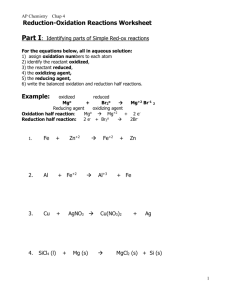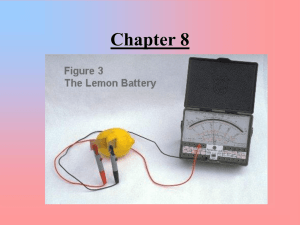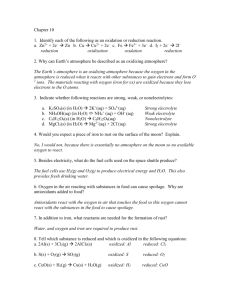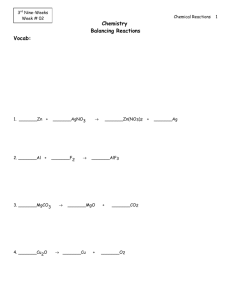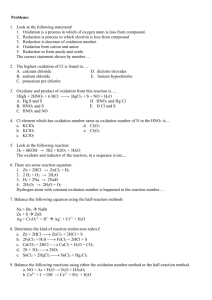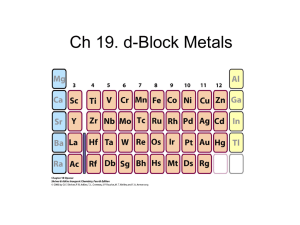400 Chem Homework Packet Unit 13 Redox
advertisement
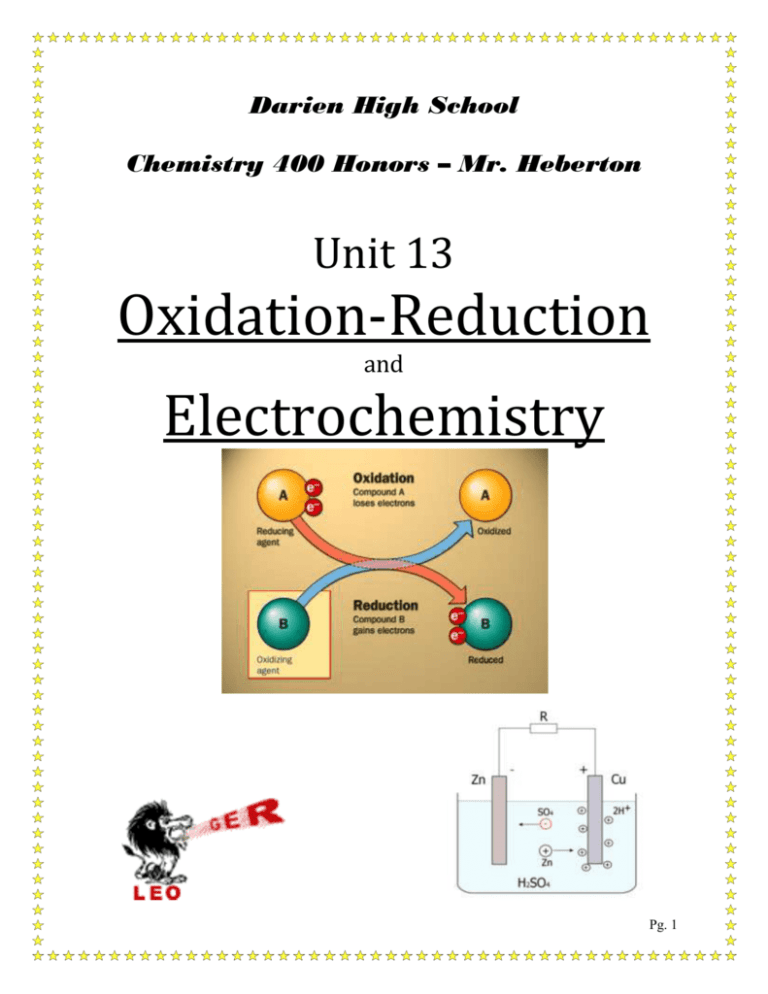
Darien High School Chemistry 400 Honors – Mr. Heberton Unit 13 Oxidation-Reduction and Electrochemistry Pg. 1 Redox & Electrochemistry 1. Definitions: a. Oxidation = oxidation number Increases due to loss of electrons during reaction b. Reduction = oxidation number is REDUCED due to the gain of electrons during the redox reaction. c. Oxidizing agent = substance that is reduced by accepting the electrons of another substance (it causes the oxidation of the other substance) d. Reducing agent = substance that is oxidized by losing electrons to another substance (it causes the reduction of the other substance) 2. Assign an oxidation state to each atom in the following. a. Au Au = 0 b. H2O H = +1, O = -2 2+ c. Mg Mg = +2 d. K2O K = +1, O = -2 e. BF3 B = +3, F = -1 (rule: fluorine almost always = -1) f. NH4+ N = -3, H= +1 g. Ca(OH)2 Ca = +2, O = -2, H= +1 h. S2O7 S = +7, O = -2 i. Fe2(CO3)3 Fe = +3, C = +4, O = -2 j. NaBiO3 Na = +1, Bi = +5, O = -2 k. NaHCO3 Na = +1, H = +1, C= +4 O = -2 2- l. Cr2O7 Cr = +6, O = -2 m. NH4NO3 first N = -3, H= +1, second N= +5, O = -2 n. H2PO4- H = +1, P = +5, O = -2 o. K2CrO4 K = +1, Cr = +6, O = -2 p. NaNO3 Na = +1, N = +5, O = -2 q. NH3 N = -3, H = +1 r. ZnO Zn = +2, O = -2 s. CaH2 Ca = +2, H = -1 (metal hydride) t. CO2 C = +4, O = -2 u. N2 N=0 v. Na2SO4 Na = +1, S = +6, O = -2 Pg. 2 3. Determine whether each of the following reactions is a redox reaction or not. For the ones that are redox reactions, identify which elements are changing in oxidation state. a. Na2S + FeCl2 → 2 NaCl + FeS +1, -2 +2, -1 +1, -1 +2, -2 nothing changed OS, thus not a redox. b. 2 Na + 2 H2O → 2 NaOH + H2 0 +1,-2 +1,-2,+1, 0 Na oxidized from 0 to +1, H reduced +1 to 0 c. 2 KClO3 → 2 KCl + 3 O2 +1,+5,-2 +1,-1 0 d. SO2 + H2O → H2SO3 +4,-2 +1,-2 +1,+4,-2 Cl reduced from +5 to -1; O oxidized from -2 to 0 Not a redox. e. 2 Al + 6 HCl → 2 AlCl3 + 3 H2 0 +1,-1 +3,-1 0 f. CH4 + 2O2 → CO2 + 2 H2O -4,+1 0 +4,-2 +1,-2 Al oxidized 0 to +3; H reduced +1 to 0 C oxidized -4 to +4, O reduced 0 to -2 g. AgNO3 + NaCl → AgCl + NaNO3 +1,+5,-2 +1,-1 +1,-1 +1,+5,-2 Not a redox 4. For each of the following reactions, identify which element is being oxidized and which element is being reduced. Be specific as you identify them (i.e., “the chromium in the chromate ion is being reduced). a. CuO + H2 → Cu + H2O copper in the oxide is reduced; hydrogen is oxidized. b. CH4 + 2O2 → CO2 + 2 H2O carbon is oxidized, oxygen is reduced in both compounds c. 2 Na + Br2 → 2 NaBr elemental sodium is oxidized, elemental bromine is reduced. d. Ca + H2O → CaO + H2 calcium is oxidized, hydrogen in water is reduced e. 2 H2 + O2 → 2 H2O elemental hydrogen is oxidized, elemental oxygen is reduced f. 4 HCl + O2 → 2 H2O + 2 Cl2 chlorine in acid is oxidized, elemental oxygen is reduced g. 4 Al + 3 O2 → 2 Al2O3 elemental aluminum is oxidized, elemental oxygen is reduced Pg. 3 5. For each of the following reactions, identify which element is being oxidized and which element is being reduced. Be specific, as you did in #4. Describe the change in oxidation state of the two elements and the number of electrons being gained or lost (i.e., “silver metal is losing 1 electron to go from an oxidation state of 0 to +1”). Then, identify the oxidizing agent and reducing agent (i.e., silver metal is oxidized, so it is the reducing agent). a. PbO2 + 4 HI → I2 + PbI2 + 2 H2O +4,-2 +1,-1 0 +2,-1 +1,-2 iodine is oxidized, lead is reduced lead oxide is the oxidizing agent, hydroiodic acid is reducing agent. b. P4 + 5 O2 → P4O10 0 0 +5,-2 phosphate is oxidized, oxygen is reduced oxygen is the oxidizing agent, phosphate is the reducing agent. c. SnCl2 + 2 FeCl3 → 2 FeCl2 + SnCl4 +2,-1 +3,-1 +2,-1 +4,-1 tin is oxidized, iron is reduced Iron chloride is the oxidizing agent, tin chloride is the reducing agent. d. 2 Na + FeCl2 → 2 NaCl + Fe 0 +2,-1 +1,-1 0 sodium is oxidized, iron is reduced Iron chloride is the oxidizing agent, sodium is the reducing agent. e. 2 C2H2 + 5 O2 → 4 CO2 + 2 H2O -1,+1 0 +4,-2 +1,-2 carbon is oxidized, oxygen is reduced Oxygen is the oxidizing agent, acetylene is the reducing agent. f. 2 PbS + 3 O2 → 2 SO2 + 2 PbO +2,-2 0 +4,-2 +2,-2 sulfur is oxidized, oxygen is reduced Oxygen is the oxidizing agent, lead sulfide is the reducing agent. g. 2 H2 + O2 → 2 H2O 0 0 +1,-2 hydrogen is oxidized, oxygen is reduced Oxygen is the oxidizing agent, hydrogen is the reducing agent. h. Cu + HNO3 → CuNO3 + H2 0 +1,+5,-2 +1,+5,-2 0 copper is oxidized, hydrogen is reduced Nitric acid is the oxidizing agent, copper is the reducing agent. i. AgNO3 + Cu → CuNO3 + Ag +1,+5,-2 0 +1,+5,-2 0 copper is oxidized, silver is reduced Silver nitrate is the oxidizing agent, copper is the reducing agent. Pg. 4 6. Determine which of the following reactions is a redox reaction. For each one that is a redox reaction, identify which substance is being oxidized and which substance is being reduced. a. 2 KNO3 → 2 KNO2 + O2 +1,+5,-2 +1,+3,-2 0 oxygen is oxidized, nitrogen is reduced b. SO2 + H2O → H2SO3 +4,-2, +1,-2 +1,+4,-2 Not a redox c. H2S + 8 HNO3 → H2SO4 + 8 NO2 + 4 H2O +1,-2 +1,+5,-2 +1,+6,-2 +4,-2 +1,-2 sulfur is oxidized, nitrogen is reduced d. Zn + CuSO4 → ZnSO4 + Cu 0 +2,+6,-2 +2,+6,-2 0 zinc is oxidized, copper is reduced e. NH3 + HCl → NH4+ + Cl-3,+1 +1,-1 -3,+1 -1 not a redox f. 10 FeSO4 + 2 KMnO4 + 8 H2SO4 → 5 Fe2(SO4)3 + 2 MnSO4 + K2SO4 + 8 H2O +2,+6,-2 +1,+7,-2 +1,+6,-2 +3,+6,-2 +2,+6,-2 +1,+6,-2 +1,-2 Iron is oxidized, manganese is reduced g. 4 Fe + 3 O2 + 6 H2O → 4 Fe(OH)3 0 0 +1,-2 +3,-2,+1 iron is oxidized, oxygen is reduced 7. Write and balance a half reaction for each of the following: a. Oxidation of magnesium metal to magnesium ion: Mg Mg2+ +2eb. Oxidation of chloride ion to chlorine gas: 2Cl- Cl2 + 2ec. Oxidation of copper metal to copper(I) ion: Cu Cu1+ +1ed. Oxidation of bromide ion to bromine liquid: 2Br- Br2 + 2ee. Reduction of hydrogen ion to hydrogen gas: 2H+ + 2e- H2 f. Reduction of oxygen gas to oxide ion: O2 + 4e- 2O2g. Reduction of aluminum ion to aluminum metal: Al3+ + 3e- Al h. Reduction of manganese(VII) ion to manganese(II) ion: Mn7+ + 5e- Mn2+ Pg. 5 8. For each reaction, write out and balance the two half reactions, then make the number of electrons transferred equal (by multiplying if necessary), and add the half reactions to get the balanced, overall equation. Remember to double check your overall reactions to make sure they are balanced for mass and charge. a. Na + N2 → Na+ + N36(Na Na+ + 1e-) N2 + 6e- 2N36Na + N2 6Na+ + 2N3b. Mg + Cl2 → Mg2+ + ClMg → Mg2+ + 2eCl2 + 2e- → 2ClMg + Cl2 → Mg2+ + 2Clc. Al + Br2 → Al3+ + Br2(Al → Al3+ + 3e-) 3(Br2 + 2e- → 2Br-) 2Al + 3Br2 → 2Al3+ + 6Brd. Fe + O2 → Fe3+ + O24(Fe → Fe3+ +3e- ) 3(O2 +4e- → 2O2-) 4Fe + 3O2 → 4Fe3+ + 6O2e. Mg + Br2 → Mg2+ + BrMg → Mg2+ + 2eBr2 + 2e- → 2BrMg + Br2 → Mg2+ + 2Brf. Na + S → Na+ + S22(Na → Na+ + 1e-) S + 2e- → S22Na + S → 2Na+ + S2g. Cl2 + Br- → Br2 + ClCl2 + 2e- → 2Cl2Br- → Br2 + 2eCl2 + 2Br- → Br2 + 2Cl- Pg. 6 9. Balance the following reactions using the “bridge” method. Detailed answer for 9a: First determine oxidation numbers. Second, balance elements undergoing redox and then determine their electron change. In this case, there needs to be two Mo on the reactant side. Each Mo is undergoing a change in OS from +6 to +3, a net gain of 3 electrons, but since there are two Mo, double this to 6e-. |-------------gain 6e- ------| a. 2MoO3 + Zn + H2SO4 → Mo2O3 + ZnSO4 + H2O +6,-2 0 1,6,-2 3,-2 2,6,-2 1,-2 |_________lose 2e _____| Third: balance redox electrons. Need to triple Zn compounds to match Mo electron change. |-------------gain 6e- ------| a. 2MoO3 + 3Zn + H2SO4 → Mo2O3 + 3ZnSO4 + H2O +6,-2 0 1,6,-2 3,-2 2,6,-2 1,-2 |_________lose 6e-_______| Fourth: Balance remainder by inspection (triple sulfuric acid and water): |-------------gain 6e- ------| a. 2MoO3 + 3Zn + 3H2SO4 → Mo2O3 + 3ZnSO4 + 3H2O +6,-2 0 1,6,-2 3,-2 2,6,-2 1,-2 |___________lose 6e-_______| All elements and electrons are now balanced. |----------gain 4 e- ------------------| c. 2H2SO3 + KIO3 + 2HCl → 2H2SO4 + KCl + ICl + H2O 1, 4,-2 1,5,-2 1,-1 1,6,-2 1,-1 1,-1 1,-2 |_______lose 4e- ________| |-----------gain 6e- -----------------| d. H3As + 6AgNO3 + 3H2O → H3AsO3 + 6Ag + 6HNO3 1,-3 1,5,-2 1,-2 1, 3,-2 0 1,5,-2 |________lose 6e-_________| |----------gain 2e- ----------------------| e. I2 + HAsO2 + 2H2O → H3AsO4 + 2HI 0 1,3,-2 1,-2 1,5,-2 1,-1 |______lose 2e- ___| Pg. 7 |--------gain 10e- ------| f. 5H2C2O4 + 2KMnO4 + 3H2SO4 → 2MnSO4 + K2SO4 + 8H2O + 10CO2 1, 3, -2 1,7, -2 1,6,-2 2, 6,-2 1, 6,-2 1,-2 4,-2 |_________________lose 10e- _________________________| |--------------gain 24e------------------| g. 4HClO3 + 3H2S → 3H2SO4 + 4HCl 1,5,-2 1,-2 1,6,-2 1,-1 |__lose 24e-__| |--------------gain 10e------------------| l. 2HMnO4 + 5Na3AsO3 + 19HNO3 → 2Mn(NO3)2 + 5H3AsO4 + 15NaNO3 + 3H2O 1, 7, -2 1, 3, -2 1,5,-2 2, 5,-2 1, 5,-2 1, 5,-2 1,-2 |_____________lose 10e-___________| Pg. 8 REDOX REACTIONS – BRIDGE METHOD II |---gain 6 e----| 1) 6HNO3 + S → 6NO2 + H2SO4 + 2H2O 1,5,-2 0 4,-2 1, 6,-2 1,-2 |_____lose 6e-__| |--------gain 6e- -----| 2) 2CrCl3 + 3MnO2 + 2H2O → 3MnCl2 + 2H2CrO4 3,-1 4,-2 1,-2 2, -1 1, 6,-2 |_____________lose 6e-______________| 3) |-----------gain 10e- --------------------| 2KMnO4 + 6HCl + 5H2S → 2KCl + 2MnCl2 + 5S + 8H2O 1, 7, -2 1,-1 1,-2 1,-1 2, -1 0 1,-2 |________lose 10e _____| 4) |------------- gains 8e- -------------------------| 8HNO 3 + H 2 S → H 2 SO 4 + 8NO 2 1,5,-2 1,-2 1,6,-2 4,-2 |__lose 8e- __| 5) 6) 2KOH 1,-2,1 + + 4H 2 O 1,-2 |------------gains 6e- ---------------| 2MnO 2 + KCl O 3 → 2KMnO 4 + KCl 4, -2 1, 5, -2 1, 7, -2 1,-1 |_____________loses 6e _______| |--------------------gains 2e- -------------| Cu + (2+2=4)HNO 3 → Cu( NO 3 ) 2 + 2 NO 2 0 1, 5, -2 2, 5, -2 4, -2 |__________loses 2e- ___________| + + H2O 1,-2 2H 2 O 1, -2 Note: only 2 N oxidize (balance first) 7) 8) |---------gains 2e- --------------| 2NaCl + 2H 2 SO 4 + MnO 2 → Na 2 SO 4 + MnSO 4 + 2H 2 O + Cl 2 1, -1 1, 6, -2 4, -2 1, 6, -2 2, 6, -2 1, -2 0 |________________________loses 2e- _______________________________| |-------------gains 6e- -----------------------| 2HNO 3 + 3I 2 + 2H 2 O → 2NO + 6HIO 1, 5, -2 0 1, -2 2, -2 1,1,-2 |____________loses 6e _____________| Pg. 9 REDOX REACTIONS – BRIDGE METHOD IV |--------------gain 10 e - ----------| 1) 2KMnO 4 + 10K I + 8H 2 SO 4 → 2MnSO 4 + 6K 2 SO 4 + 8H 2 O + 5I 2 1, 7, -2 1, -1 1,6, -2 2, 6, -2 1,6, -2 1, -2 0 |_____________lose 10 e - ___ _________________| 2) K 2 Cr 2 O 7 3) Na 2 C 2 O 4 + 4) MnO 5) MnO 2 6) HNO 3 7) FeSO 4 + + HCl KMnO 4 + + → + → HI → MnCl 2 NO H 2 SO 4 → CrCl 3 K 2 SO 4 + HNO 3 → HCl K 2 Cr 2 O 7 + + H 2 SO 4 → PbO 2 + + KCl + + H2O Na 2 SO 4 + HMnO 4 + + Cl 2 I2 + Fe 2 (SO 4 ) 3 + Cl 2 H2O + Pb(NO 3 ) 2 + + MnSO 4 + + CO 2 H2O H2O H2O Cr 2 (SO 4 ) 3 + K 2 SO 4 + H2O Pg. 10 12. Calculate the standard cell potential produced by a voltaic cell consisting of a nickel electrode in contact with a solution of Ni2+ ions and a silver electrode in contact with a solution of Ag+ ions. Detailed answer: Standard Reduction Potentials for each half cell reaction: Ni2+ + 2e- Ni Ag1+ + 1e- Ag Eo = -0.25 V Eo = +0.80 V Since Ag has a higher reduction potential than Ni, Ag has the greater affinity for electrons and will be reduced (GER). Ni will be oxidized, thus its equation and voltage needs to be reversed: Ni Ni2+ + 2e- Eo = +0.25 V Add this to the reduction reaction (which must be multiplied by two to balance the transfer of electrons) to determine the overall cell potential: Ni Ni2+ + 2e2(Ag1+ + 1e- Ag) 2Ag1+ + Ni Ni2+ + 2Ag Eo = +0.25 V oxidation Eo = +0.80 V reduction Eocell = +1.05 V 13. What is the voltage produced by a voltaic cell consisting of an aluminum electrode in contact with a solution of Al3+ ions and an iron electrode in contact with a solution of Fe2+ ion? Aluminum is oxidized since its Eo is lowest, thus its equation is shown reversed. Also must balance electrons: 2(Al Al3+ + 3e-) 3(Fe2+ + 2e- Fe) 3Fe2+ + 2Al 3Fe + 2Al Eo = +1.66 V oxidation Eo = -0.44 V reduction Eocell = +1.22 V 14. Calculate the standard cell potential produced by a voltaic cell consisting of a sodium electrode in contact with a solution of Na+ ions and a copper electrode in contact with a solution of Cu2+ ions. 2(Na Na+ + 1e-) Cu2+ + 2e- Cu 2Na + Cu2+ 2Na+ + Cu Eo = +2.71 V oxidation Eo = +0.34 V reduction Eocell = +3.05 V Pg. 11 15. What is the voltage produced by a voltaic cell consisting of a calcium electrode in contact with a solution of Cu2+ ions? Ca Ca+2 + 2eCu2+ + 2e- Cu Ca + Cu2+ Ca+2 + Cu Eo = +2.76 V oxidation Eo = +0.34 V reduction Eocell = +3.10 V 16. A voltaic cell is constructed using electrodes based on the following half reactions: Pb2+ (aq) + 2e- → Pb(s) Au3+(aq) +3e- → Au(s) E o = -0.13 V E o = +1.50 V a. Which is the anode and which is the cathode in this cell? Based on their relative SRPs, Pb reaction will be reversed and will undergo oxidation. Oxidation occurs at the anode, which will be lead. Gold will be the cathode. b. What is the standard cell potential? 3(Pb(s) → Pb2+ (aq) + 2e-) E o = +0.13 V 3+ 2(Au (aq) +3e- → Au(s)) E o = +1.50 V 3+ 2+ 3Pb(s) + 2Au (aq)→ Pb (aq)+ Au(s) Eocell = +1.63 V 17. Calculate the standard cell potential produced by a voltaic cell consisting of a nickel electrode in contact with a solution of Ni2+ ions and a copper electrode in contact with a solution of Cu2+ ions. Ni Ni+2 + 2eCu2+ + 2e- Cu Ni + Cu2+ Ni+2 + Cu Eo = +0.25 V oxidation Eo = +0.34 V reduction Eocell = +0.59 V 18. A voltaic cell is constructed using electrodes based on the following half reactions: Mn2+ (aq) + 2e- → Mn(s) Cu2+ (aq) +2e- → Cu(s) Which is the anode and which is the cathode in this cell? What is the standard cell potential? Mn is the anode (Eo = -1.18V) and Cu is the cathode (Eo = +0.34V) Mn Mn+2 + 2eCu2+ + 2e- Cu Ni + Cu2+ Ni+2 + Cu Eo = +1.18 V oxidation Eo = +0.34 V reduction Eocell = +1.52 V Pg. 12 19. What is the voltage produced by a voltaic cell consisting of a lead electrode in contact with a solution of Pb2+ ions and an iron electrode in contact with a solution of Fe2+? Which is anode and which is the cathode? Fe is the anode (Eo = -0.44V) and Pb is the cathode (Eo = -0.13V) Fe Fe+2 + 2ePb2+ + 2e- Pb Fe + Pb2+ Fe+2 + Pb Eo = +0.44 V oxidation Eo = -0.13 V reduction Eocell = +0.31 V 20. What is the voltage produced by a voltaic cell consisting of a zinc electrode in contact with a solution of Zn2+ ions and a silver electrode in contact with a solution of Ag+ ions? Zn Zn+2 + 2eAg+ + 1e- Ag Zn + Ag+ Zn+2 + Ag Eo = +0.76 V oxidation Eo = +0.80 V reduction Eocell = +1.56 V 21. Calculate the standard cell potential produced by a voltaic cell consisting of a gold electrode in contact with a solution of Au3+ ions and a silver electrode in contact with a solution of Ag+ ions. Which is the anode and which is the cathode? Ag is the anode (Eo = +0.80V) and Au is the cathode (Eo = +1.50V) Ag Ag+ + 1eAu3+ + 3e- Au Ag + Au3+ Ag+ + Au Eo = -0.80 V oxidation Eo = +1.50 V reduction Eocell = +0.70 V Pg. 13 22. Two half-cells, one containing Fe2+ and Fe and the other containing Ag+ and Ag, are connected to form a voltaic cell. Use a Standard Reduction Potential table to determine the direction of spontaneous reaction and the value for E°cell. Diagram the cell and label its parts. Give equations for the half reactions. 23. Two half cells, one containing Ca2+ and Ca and the other containing Ag+ and Ag, are connected to form a voltaic cell. Use a Standard Reduction Potential table to determine the direction of spontaneous reaction and the value for E°cell. Diagram the cell and label its parts. Give equations for the half reactions. 24. Is the following redox reaction spontaneous as written? (Hint: Write oxidation and reduction halfreactions; look up the standard reduction potentials, and find E°cell; if E° is positive, the reaction is spontaneous!) 2Ag+ + Ni ↔ 2Ag + Ni2+ 25. Decide if the following redox reaction is spontaneous as written: (see hint in #24) Cr3+ + Al ↔ Cr + Al3+ Pg. 14


